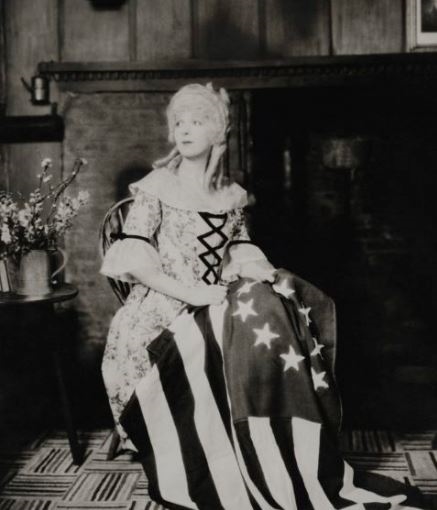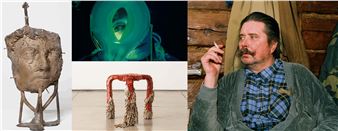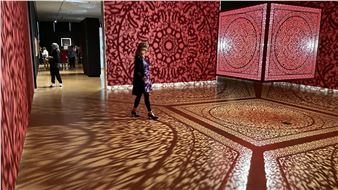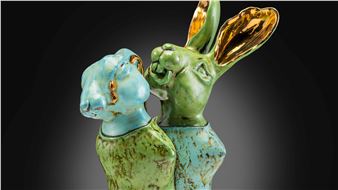Charles Sheeler: Fashion, Photography, and Sculptural Form
A Philadelphia native and Doylestown resident of the Worthington House between 1910-1926, Charles Sheeler (1883ÔÇô1965) is recognized as one of the founding figures of American modernism for his pioneering work as both a painter and a photographer, with a particular penchant for industrial subjects. Trained in an impressionist approach to landscape painting, Sheeler experimented early in his career with compositions inspired by European modernism before developing a linear, hard-edged style now known as Precisionism. He purchased his first camera in 1910, around the time he moved to Doylestown. A few years later, using his house as his primary subject, he began experimenting with compositional arrangement: mass, texture, line, dramatic lighting, spatial distortions, and framing strategies to create powerful images. At the same time, he produced compelling images of Machine Age New York for which he is best known: Art Deco skyscrapers, sleek locomotive engines, and majestic power plants.
However, around the time he moved to New York permanently, Sheeler was hired as a staff photographer by his friend, Edward Steichen, then director of photography for Cond├® Nast magazines, with the assignment to take photographs for Vogue and Vanity Fair, which he did until he left the position in 1931. SheelerÔÇÖs Cond├® Nast work has been almost universally dismissed as purely commercial, a painterÔÇÖs ÔÇ£day job,ÔÇØ and nothing more. Very few of these photographs have ever been published, and none of the nearly 352 photographs he produced for the magazines have been exhibited before. That is, until now. Charles Sheeler: Fashion, Photography, and Sculptural Form, on view at the Michener Art Museum in March 2017, will be the first monographic exhibition of SheelerÔÇÖs work at the Museum, and the first anywhere to explore his Cond├® Nast period, its roots in his early experimentations with photography, and its lasting impact on his mature body of work.
The exhibition will begin with an exploration of SheelerÔÇÖs early period of experimentation: photographs of the Worthington House and modern sculpture, early portraits, and his 1920 film collaboration with Paul Strand, Manhatta. The core of Charles Sheeler: Fashion, Photography, and Sculptural Form, however, are the 85 portraits and fashion photographs on loan from the Cond├® Nast archives in New York. These photographs embody all the glamour of the Jazz AgeÔÇöbeautiful starlets in fantastic gowns and fabulous jewels, models wearing the latest in couture designs, Ziegfeld Follies dancers, and stage actors featured in the latest Broadway sensation. A number of these photographs will be included in staged, multi-media vignettes incorporating period costumes, additional photographs, and paintings on loan from The Museum of Fine Arts, Boston, Yale University Art Gallery, the Virginia Museum of Fine Arts, the Columbus Museum of Art, the Metropolitan Museum of Art, the Gaston Lachaise Foundation, and the Whitney Museum of American Art. Additionally, visitors will see for the first time SheelerÔÇÖs own textile designs, which he produced in the early 1930s. These will be accompanied by a photograph Sheeler took of his dealer, Edith Halpert, wearing a dress made from his textiles, standing between two of his recent industrial paintings. Pieces of the original dress, as well as a recreation of it, will also be included in one of the multi-media vignettes.

Recommended for you
A Philadelphia native and Doylestown resident of the Worthington House between 1910-1926, Charles Sheeler (1883ÔÇô1965) is recognized as one of the founding figures of American modernism for his pioneering work as both a painter and a photographer, with a particular penchant for industrial subjects. Trained in an impressionist approach to landscape painting, Sheeler experimented early in his career with compositions inspired by European modernism before developing a linear, hard-edged style now known as Precisionism. He purchased his first camera in 1910, around the time he moved to Doylestown. A few years later, using his house as his primary subject, he began experimenting with compositional arrangement: mass, texture, line, dramatic lighting, spatial distortions, and framing strategies to create powerful images. At the same time, he produced compelling images of Machine Age New York for which he is best known: Art Deco skyscrapers, sleek locomotive engines, and majestic power plants.
However, around the time he moved to New York permanently, Sheeler was hired as a staff photographer by his friend, Edward Steichen, then director of photography for Cond├® Nast magazines, with the assignment to take photographs for Vogue and Vanity Fair, which he did until he left the position in 1931. SheelerÔÇÖs Cond├® Nast work has been almost universally dismissed as purely commercial, a painterÔÇÖs ÔÇ£day job,ÔÇØ and nothing more. Very few of these photographs have ever been published, and none of the nearly 352 photographs he produced for the magazines have been exhibited before. That is, until now. Charles Sheeler: Fashion, Photography, and Sculptural Form, on view at the Michener Art Museum in March 2017, will be the first monographic exhibition of SheelerÔÇÖs work at the Museum, and the first anywhere to explore his Cond├® Nast period, its roots in his early experimentations with photography, and its lasting impact on his mature body of work.
The exhibition will begin with an exploration of SheelerÔÇÖs early period of experimentation: photographs of the Worthington House and modern sculpture, early portraits, and his 1920 film collaboration with Paul Strand, Manhatta. The core of Charles Sheeler: Fashion, Photography, and Sculptural Form, however, are the 85 portraits and fashion photographs on loan from the Cond├® Nast archives in New York. These photographs embody all the glamour of the Jazz AgeÔÇöbeautiful starlets in fantastic gowns and fabulous jewels, models wearing the latest in couture designs, Ziegfeld Follies dancers, and stage actors featured in the latest Broadway sensation. A number of these photographs will be included in staged, multi-media vignettes incorporating period costumes, additional photographs, and paintings on loan from The Museum of Fine Arts, Boston, Yale University Art Gallery, the Virginia Museum of Fine Arts, the Columbus Museum of Art, the Metropolitan Museum of Art, the Gaston Lachaise Foundation, and the Whitney Museum of American Art. Additionally, visitors will see for the first time SheelerÔÇÖs own textile designs, which he produced in the early 1930s. These will be accompanied by a photograph Sheeler took of his dealer, Edith Halpert, wearing a dress made from his textiles, standing between two of his recent industrial paintings. Pieces of the original dress, as well as a recreation of it, will also be included in one of the multi-media vignettes.

 ARTISTS
ARTISTS
















